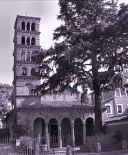Lent: April 4th
Monday of the Fifth Week of Lent; Optional Memorial of Saint Isidore, Bishop and Doctor of the Church
» Enjoy our Liturgical Seasons series of e-books!
Entrance Antiphon, Cf. Ps 56 (55):2:
Have mercy on me, O God, for people assail me; they fight me all day long and oppress me.
Today we begin the fifth and final full week of Lent. In previous times the crosses and statues in church were veiled at this time to indicate Passion Time. Now the liturgical readings, day after day, tell of the lowering storm clouds that next week will break open. Today’s ancient Lenten readings taught the penitents (and teach us) that every sin is adultery to God—and is pardonable by Christ. —The Vatican II Weekday Missal
St. Isidore, who succeeded his brother St. Leander as Archbishop of Seville, was one of the great bishops of the seventh century. He was proficient in all brances of knowledge and was regarded as one of the most learned men of his time; with Cassiodorus and Boethius he was one of the thinkers whose writings were most studied in the Middle Ages, St. Isidore died in 636. Pope Innocent XIII canonized him in 1722 and proclaimed him a Doctor of the Church.
Meditation
In early Christian biblical commentary, the innocent Susanna of today’s first Mass reading was presented as a type of the unjustly persecuted Church. Thus the assignment of the Susanna story to today’s liturgy is particularly appropriate given today’s statio at St. Chrysogonus, who, like Sebastian and George, was a soldier-martyr of the Diocletian persecution in the early fourth century. Veneration of St. Chrysogonus was so widespread in Rome that his name was inscribed in the Roman Canon (Eucharistic Prayer I). Chrysogonus conformed himself to the sacrifice of Christ on Calvary by offering his own life in witness to the grace of God that had transformed him. So did St. John Fisher, who provides the second selection in today’s Office of Readings. Fisher reminds Lenten pilgrims that the imitation of Christ, while perfected in martyrdom, also takes place in many other ways: “All who have embarked on true contrition and penance for the sins they have committed, and are firmly resolved not to commit sins again for the future but to persevere constantly in that pursuit of virtues which they have now begun, all these become sharers in [Christ’s] holy and eternal sacrifice.”
—George Weigel, Roman Pilgrimage: The Station Churches
St. Isidore of Seville
Isidore, archbishop of Seville and brother of the saintly Bishop Leander, ranks as the most outstanding person in the Church of Spain during the seventh century. Because of the singular holiness of his life, he was idolized by the people. Wherever he appeared, throngs gathered about him. "Some came to see the miracles that he performed in the name of the Lord. The sick came to be freed from their sufferings, for the power of God emanated from him and he would heal them all" (Bollandists: April 1, 340).
He is regarded as the great restorer of the Spanish Church after the Visigoths returned to the Catholic faith. He also contributed greatly to the development of Spain's liturgy. He presided over the fourth provincial council of Toledo (633), the most important in Spanish history. Rich in merit, he died in 636 after ruling his see 40 years. St. Gregory the Great was one of his personal friends.
Patronage: Computer technicians; computer users; computers; the Internet; schoolchildren; students.
Symbols and Representation: Bees; bishop holding a pen while surrounded by a swarm of bees; bishop standing near a beehive; old bishop with a prince at his feet; pen; priest or bishop with pen and book; with Saint Leander, Saint Fulgentius, and Saint Florentina; with his Etymologia.
Highlights and Things to Do: Monday of the 5th Week of Lent For further information on the Station Churches, see The Stational Church.
—Excerpted from 
Station with San Crisogono in Trastevere (St. Chrysogonus in Trastevere):
The Station, at Rome, is in the church of St. Chrysogonus, one of the most celebrated martyrs of the Church of Rome. His name is inserted in the Canon of the Mass. The church was probably built in the 4th century under Pope Sylvester I and one of the tituli, the first parish churches of Rome, known as the Titulus Chrysogoni.








